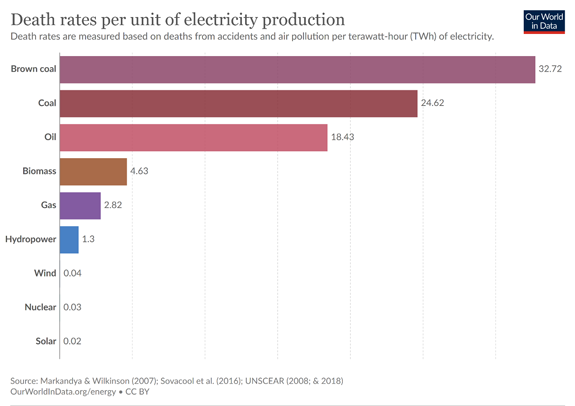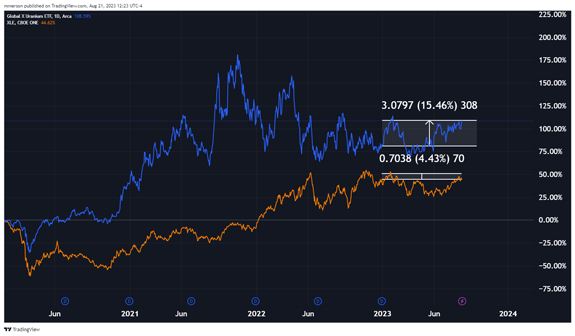 | No matter how you feel about President Biden, there’s only one logical way to feel about his Inflation Reduction Act: Bullish on the future of energy.
Despite the name, this legislation represents one of the largest spending packages in U.S. history. Of the $500 billion in planned spending, $369 billion is going straight into the transition to renewable energy — the White House’s top focus.
But tucked away in the bill, beneath the reams of dollars headed straight for renewable sources like wind and solar, was a substantial tax credit for a highly efficient, safe, yet outright despised renewable energy source…
I’m talking about nuclear power.
For decades, nuclear power has suffered a stigma from investors and world leaders alike due to the impact of just three sore spots in its entire history.
That’s left it hated, feared and neglected as an asset — especially since the last major incident, the Fukushima nuclear meltdown back in 2011.
Today, though, nuclear energy stocks have caught a tailwind. They’re carving out a new uptrend. And investors who place a small stake in it now can comfortably still call themselves early on what I believe could become an outlier in the larger renewable energy mega trend.
That’s why this Stock Power Daily is about helping you understand the opportunity that stands before us in nuclear energy … and showing you the simplest way to take part.
 | From our Partners at Monument Traders Alliance. Research found that smart investors could have made top gains of... - 443% in 11 days
- 89% in 11 days
- 543% in nine days
- 88% in seven days.
All by trading just one ticker every week! Sound preposterous? SEE THE PROOF HERE. |
A Dark Cloud Is Clearing A dark cloud of sentiment has hung over the broader nuclear industry for well over a decade. Now, it’s on the verge of clearing.
A recent Gallup survey indicated that 55% of Americans favor the use of nuclear energy, the highest reading since right after the 2011 Fukushima incident. The survey also showed the lowest opposition to the industry since 2015.
This should be no surprise when you consider the track record. Nuclear power plants have existed since the 1950s … and we can count the number of significant accidents on one hand: Three Mile Island in 1979, Chernobyl in 1986 and Fukushima in 2011.
Put up against fossil fuels, and even other green energy sources, the level of safety is miles apart. The chart below shows that nuclear isn’t just safer than coal, oil and natural gas … but also hydroelectric power.
How dangerous is it? About as dangerous as wind power.  At the same time, nuclear is one of the most efficient methods of energy production we have. A typical nuclear reactor produces about one gigawatt of electricity per year with near-zero carbon emissions, while requiring drastically less land than wind farms (0.05% on average) or solar fields (0.25%).
And while nuclear power plants are more expensive to build out, they last much longer than solar or wind farms — often a decade or more. They also require far less refueling and maintenance, only once every one to two years.
But beyond capital and land resources, nuclear most importantly requires far fewer raw materials to produce. Measured as the number of metric tons of materials per terawatt-hour of energy produced, wind turbines require 10 times the raw materials of nuclear … and solar panel arrays require 16 times more.
Despite all this, nuclear has long had a reputation for being dirty and even violent. The incidents I mentioned above, along with the end of World War II and depictions of nuclear power plants in popular media (remember the three-eyed fish from The Simpsons?), are at least partly to blame.
Almost half of Americans still hold this bias. But the ones that don’t, and can see the writing on the wall, are getting busy turning the tide.
For example, Georgia Power Co. recently opened the 1,100-megawatt Vogtle facility. This facility, the first new nuclear reactor since 2016, has the capacity to power half a million homes and businesses.
Further, there are plans for another new reactor in the same location to begin operation between November 2023 and March 2024. These two reactors combined will make Vogtle the largest nuclear plant in the country.
This opening comes at the perfect time, considering the Inflation Reduction Act provides a tax break to nuclear facilities operating from 2024 to 2032. Every megawatt hour of energy these facilities produce will earn them a $15 tax credit.
If the average nuclear power plant generates one gigawatt of electricity per year (1,000 megawatts), that totals out to a $15 million tax credit per plant.
You can see the incentive for nuclear power beginning to take shape right before our eyes. The narrative tide is shifting, and the capital is shifting along with it.
So how you can follow that capital into a pro-nuclear future for the U.S.? A Turnkey Nuclear Trade The easiest way to place your chips on the nuclear energy mega trend is to invest in the Global X Uranium ETF (NYSE: URA). This exchange-traded fund (ETF) holds a basket of nuclear energy companies from around the world. And despite the broader slump in energy stocks in 2023, URA has outperformed.
URA is up over 15% year to date, while the Energy Select Sector SPDR Fund (NYSE: XLE) is up just over 4%. And since the start of 2020, URA is outperforming XLE by 2-to-1. URA’s Energy Outperformance  (Click here to view larger image.) URA is a great, fairly low-risk way to capitalize on the trend. But it’s certainly not the one with the greatest upside.
Nuclear companies based in the U.S. stand to do much better as the IRA’s tax credits take hold.
I recently shared the name of one such company with my Green Zone Fortunes subscribers. And it’s not simply any old U.S. nuclear energy company. This stock has an effective monopoly with the U.S. government when it comes to a specific, essential part of nuclear power.
Recently, it got approval to begin commercial production of its high-efficiency uranium enrichment process — which is a staple of modern nuclear reactors.
And it announced a partnership with another major nuclear company founded by one of the world’s richest men.
I delivered an update on this stock recently to my Green Zone Fortunes, reiterating my buy guidance for anyone who hasn’t yet gotten in. (Subscribers can read that update here.)
But if you aren’t yet a Green Zone Fortunes member and want to learn the name of this outlier nuclear energy company, along with my other top renewable energy stock recommendations, go here and learn how you can secure your membership.
To good profits,

Adam O'Dell
Chief Investment Strategist, Money & Markets P.S. The Money & Markets team is about to release its first book! It shows you 50 ways that today’s ultra-wealthy unlock seemingly endless streams of income. We’ll have more details on how you can obtain a copy next Tuesday, August 29. Keep checking out Stock Power Daily this week for more insights into this upcoming release.
Check Out More From Stock Power Daily: |
Privacy Policy
The Money & Markets, P.O. Box 8378, Delray Beach, FL 33482.
To ensure that you receive future issues of Money & Markets, please add info@mb.moneyandmarkets.com to your address book or whitelist within your spam settings. For customer service questions or issues, please contact us for assistance.
The mailbox associated with this email address is not monitored, so please do not reply. Your feedback is very important to us so if you would like to contact us with a question or comment, please click here: https://moneyandmarkets.com/contact-us/
Legal Notice: This work is based on what we've learned as financial journalists. It may contain errors and you should not base investment decisions solely on what you read here. It's your money and your responsibility. Nothing herein should be considered personalized investment advice. Although our employees may answer general customer service questions, they are not licensed to address your particular investment situation. Our track record is based on hypothetical results and may not reflect the same results as actual trades. Likewise, past performance is no guarantee of future returns. Certain investments carry large potential rewards but also large potential risk. Don't trade in these markets with money you can't afford to lose. Money & Markets permits editors of a publication to recommend a security to subscribers that they own themselves. However, in no circumstance may an editor sell a security before our subscribers have a fair opportunity to exit. Any exit after a buy recommendation is made and prior to issuing a sell notification is forbidden. The length of time an editor must wait after subscribers have been advised to exit a play depends on the type of publication.
(c) 2023 Money & Markets, LLC. All Rights Reserved. Protected by copyright laws of the United States and treaties. This Newsletter may only be used pursuant to the subscription agreement. Any reproduction, copying, or redistribution, (electronic or otherwise) in whole or in part, is strictly prohibited without the express written permission of Money & Markets. P.O. Box 8378, Delray Beach, FL 33482. (TEL: 800-684-8471)
Remove your email from this list: Click here to Unsubscribe | | |
Post a Comment
Post a Comment